Effects of Engine Load and Ternary Mixture on Combustion and Emissions from a Diesel Engine Using Later Injection Timing
Abstract
:1. Introduction
2. Materials and Methods
2.1. Engine and Fuel
2.2. Experimental Conditions and Measurements
3. Experimental Results and Discussion
3.1. Combustion Characteristics
3.1.1. Pressure in the Cylinder
3.1.2. Heat Release Rate in the Cylinder
3.1.3. Brake Specific Fuel Consumption
3.2. Emission Characteristics
3.2.1. Carbon Monoxide
3.2.2. Hydrocarbon
3.2.3. Nitrogen Oxide
3.2.4. Smoke Opacity
4. Conclusions
- (1)
- For the combustion characteristics, the maximum pressure and the maximum heat release rate (HRR) in the cylinder are increased with increase in engine load, but the brake specific fuel consumption (BSFC) is significantly reduced; the addition of ethanol has no significant difference in the variation of maximum in-cylinder pressure, but it respectively increases the maximum HRR and BSFC by 12.95% and 3.98% on average.
- (2)
- For the emission characteristics, overall, as the load increases, carbon monoxide (CO) emissions of all test fuels show a trend of decreasing first and then increasing, hydrocarbon (HC) emissions show a trend of gradually decreasing, while nitrogen oxide (NOx) emissions and smoke opacity both show a trend of gradually increasing. Compared with diesel fuel, the addition of ethanol reduces CO emissions under high load of 120 Nm; the addition of 5 vol.% ethanol with an appropriate amount reduces HC emissions under all loads; the addition of ethanol reduces NOx emissions under 80 Nm and 120 Nm; the addition of 5 vol.% and 10 vol.% ethanol reduces smoke opacity under all loads; on the whole, the effect of adding ethanol on NOx and smoke emissions reduction is the most obvious at 80 Nm and 120 Nm, respectively, with an average reduction of 5.67% and 36.08% respectively.
Author Contributions
Funding
Institutional Review Board Statement
Informed Consent Statement
Data Availability Statement
Conflicts of Interest
Abbreviations
References
- Liu, H.; Wang, Z.; Wang, J.; He, X. Improvement of emission characteristics and thermal efficiency in diesel engines by fueling gasoline/diesel/PODEn blends. Energy 2016, 97, 105–112. [Google Scholar] [CrossRef]
- Xu, G.; Jia, M.; Li, Y.; Chang, Y.; Liu, H.; Wang, T. Evaluation of variable compression ratio (VCR) and variable valve timing (VVT) strategies in a heavy-duty diesel engine with reactivity controlled compression ignition (RCCI) combustion under a wide load range. Fuel 2019, 253, 114–128. [Google Scholar] [CrossRef]
- Basaran, H.U.; Ozsoysal, O.A. Effects of application of variable valve timing on the exhaust gas temperature improvement in a low-loaded diesel engine. Appl. Therm. Eng. 2017, 122, 758–767. [Google Scholar] [CrossRef]
- Honardar, S.; Busch, H.; Schnorbus, T.; Severin, C.; Kolbeck, A.F.; Korfer, T. Exhaust Temperature Management for Diesel Engines Assessment of Engine Concepts and Calibration Strategies with Regard to Fuel Penalty; SAE Technical Paper; SAE International: Warrendale, PA, USA, 2011. [Google Scholar]
- Zhang, Z.; Ye, J.; Tan, D.; Feng, Z.; Luo, J.; Tan, Y.; Huang, Y. The effects of Fe2O3 based DOC and SCR catalyst on the combustion and emission characteristics of a diesel engine fueled with biodiesel. Fuel 2021, 290, 120039. [Google Scholar] [CrossRef]
- Meng, Z.; Chen, C.; Li, J.; Fang, J.; Tan, J.; Qin, Y.; Jiang, Y.; Qin, Z.; Bai, W.; Liang, K. Particle emission characteristics of DPF regeneration from DPF regeneration bench and diesel engine bench measurements. Fuel 2020, 262, 116589. [Google Scholar] [CrossRef]
- Ko, J.; Si, W.; Jin, D.; Myung, C.-L.; Park, S. Effect of active regeneration on time-resolved characteristics of gaseous emissions and size-resolved particle emissions from light-duty diesel engine. J. Aerosol Sci. 2016, 91, 62–77. [Google Scholar] [CrossRef]
- Bai, S.; Tang, J.; Wang, G.; Li, G. Soot loading estimation model and passive regeneration characteristics of DPF system for heavy-duty engine. Appl. Therm. Eng. 2016, 100, 1292–1298. [Google Scholar] [CrossRef]
- Guan, B.; Zhan, R.; Lin, H.; Huang, Z. Review of state of the art technologies of selective catalytic reduction of NOx from diesel engine exhaust. Appl. Therm. Eng. 2014, 66, 395–414. [Google Scholar] [CrossRef]
- Baik, J.H.; Yim, S.D.; Nam, I.-S.; Mok, Y.S.; Lee, J.-H.; Cho, B.K.; Oh, S.H. Control of NOx emissions from diesel engine by selective catalytic reduction (SCR) with urea. Top. Catal. 2004, 30, 37–41. [Google Scholar] [CrossRef]
- Hountalas, D.T.; Mavropoulos, G.C.; Binder, K.B. Effect of exhaust gas recirculation (EGR) temperature for various EGR rates on heavy duty DI diesel engine performance and emissions. Energy 2008, 33, 272–283. [Google Scholar] [CrossRef]
- Elkelawy, M.; Alm-Eldin Bastawissi, H.; Esmaeil, K.K.; Radwan, A.M.; Panchal, H.; Sadasivuni, K.K.; Ponnamma, D.; Walvekar, R. Experimental studies on the biodiesel production parameters optimization of sunflower and soybean oil mixture and DI engine combustion, performance, and emission analysis fueled with diesel/biodiesel blends. Fuel 2019, 255, 115791. [Google Scholar] [CrossRef]
- Singh, A.; Sinha, S.; Choudhary, A.K.; Panchal, H.; Elkelawy, M.; Sadasivuni, K.K. Optimization of performance and emission characteristics of CI engine fueled with Jatropha biodiesel produced using a heterogeneous catalyst (CaO). Fuel 2020, 280, 118611. [Google Scholar] [CrossRef]
- Sekhar, S.C.; Karuppasamy, K.; Vedaraman, N.; Kabeel, A.E.; Sathyamurthy, R.; Elkelawy, M.; Bastawissi, H.A.E. Biodiesel production process optimization from Pithecellobium dulce seed oil: Performance, combustion, and emission analysis on compression ignition engine fuelled with diesel/biodiesel blends. Energy Convers. Manag. 2018, 161, 141–154. [Google Scholar] [CrossRef]
- Elkelawy, M.; Bastawissi, H.A.-E.; Esmaeil, K.K.; Radwan, A.M.; Panchal, H.; Sadasivuni, K.K.; Suresh, M.; Israr, M. Maximization of biodiesel production from sunflower and soybean oils and prediction of diesel engine performance and emission characteristics through response surface methodology. Fuel 2020, 266, 117072. [Google Scholar] [CrossRef]
- Elkelawy, M.; Alm-Eldin Bastawissi, H.; El Shenawy, E.A.; Taha, M.; Panchal, H.; Sadasivuni, K.K. Study of performance, combustion, and emissions parameters of DI-diesel engine fueled with algae biodiesel/diesel/n-pentane blends. Energy Convers. Manag. X 2021, 10, 100058. [Google Scholar] [CrossRef]
- An, H.; Yang, W.M.; Chou, S.K.; Chua, K.J. Combustion and emissions characteristics of diesel engine fueled by biodiesel at partial load conditions. Appl. Energy 2012, 99, 363–371. [Google Scholar] [CrossRef]
- Shahir, N.S.; Masjuki, N.H.; Kalam, M.; Imran, A.; Ashraful, A. Performance and emission assessment of diesel–biodiesel–ethanol/bioethanol blend as a fuel in diesel engines: A review. Renew. Sustain. Energy Rev. 2015, 48, 62–78. [Google Scholar] [CrossRef]
- Yilmaz, N. Comparative analysis of biodiesel–ethanol–diesel and biodiesel–methanol–diesel blends in a diesel engine. Energy 2012, 40, 210–213. [Google Scholar] [CrossRef]
- Kwanchareon, P.; Luengnaruemitchai, A.; Jai-In, S. Solubility of a diesel–biodiesel–ethanol blend, its fuel properties, and its emission characteristics from diesel engine. Fuel 2007, 86, 1053–1061. [Google Scholar] [CrossRef]
- Noorollahi, Y.; Azadbakht, M.; Ghobadian, B. The effect of different diesterol (diesel–biodiesel–ethanol) blends on small air-cooled diesel engine performance and its exhaust gases. Energy 2018, 142, 196–200. [Google Scholar] [CrossRef]
- Qi, D.; Leick, M.; Liu, Y.; Chia-fon, F.L. Effect of EGR and injection timing on combustion and emission characteristics of split injection strategy DI-diesel engine fueled with biodiesel. Fuel 2011, 90, 1884–1891. [Google Scholar] [CrossRef]
- Zhuang, J.; Qiao, X.; Bai, J.; Hu, Z. Effect of injection-strategy on combustion, performance and emission characteristics in a DI-diesel engine fueled with diesel from direct coal liquefaction. Fuel 2014, 121, 141–148. [Google Scholar] [CrossRef]
- Tse, H.; Leung, C.W.; Cheung, C.S. Investigation on the combustion characteristics and particulate emissions from a diesel engine fueled with diesel-biodiesel-ethanol blends. Energy 2015, 83, 343–350. [Google Scholar] [CrossRef]
- Sittichompoo, S.; Theinnoi, K.; Sawatmongkhon, B.; Wongchang, T.; Iamcheerangkoon, T.; Phugot, S. Promotion effect of hydrogen addition in selective catalytic reduction of nitrogen oxide emissions from diesel engines fuelled with diesel-biodiesel-ethanol blends. Alex. Eng. J. 2022, 61, 5383–5395. [Google Scholar] [CrossRef]
- Wei, L.; Cheung, C.S.; Ning, Z. Effects of biodiesel-ethanol and biodiesel-butanol blends on the combustion, performance and emissions of a diesel engine. Energy 2018, 155, 957–970. [Google Scholar] [CrossRef]
- Venu, H.; Raju, V.D.; Lingesan, S.; Elahi, M.; Soudagar, M. Influence of Al2O3 nano additives in ternary fuel (diesel-biodiesel-ethanol) blends operated in a single cylinder diesel engine: Performance, combustion and emission characteristics. Energy 2021, 215, 119091. [Google Scholar] [CrossRef]
- Zhu, L.; Cheung, C.S.; Zhang, W.G.; Huang, Z. Combustion, performance and emission characteristics of a DI diesel engine fueled with ethanol–biodiesel blends. Fuel 2011, 90, 1743–1750. [Google Scholar] [CrossRef]
- Okcu, M.; Varol, Y.; Altun, Ş.; Fırat, M. Effects of isopropanol-butanol-ethanol (IBE) on combustion characteristics of a RCCI engine fueled by biodiesel fuel. Sustain. Energy Technol. Assess. 2021, 47, 101443. [Google Scholar] [CrossRef]
- Padala, S.; Woo, C.; Kook, S.; Hawkes, E.R. Ethanol utilisation in a diesel engine using dual-fuelling technology. Fuel 2013, 109, 597–607. [Google Scholar] [CrossRef]
- Mukhtar, N.A.; Hagos, F.Y.; Aziz, A.R.A.; Abdulah, A.A.; Karim, Z.A.A. Combustion characteristics of tri-fuel (diesel-ethanol-biodiesel) emulsion fuels in CI engine with micro-explosion phenomenon attributes. Fuel 2022, 312, 122933. [Google Scholar] [CrossRef]
- Shirneshan, A.; Bagherzadeh, S.A.; Najafi, G.; Mamat, R.; Mazlan, M. Optimization and investigation the effects of using biodiesel-ethanol blends on the performance and emission characteristics of a diesel engine by genetic algorithm. Fuel 2021, 289, 119753. [Google Scholar] [CrossRef]
- Tutak, W.; Jamrozik, A.; Pyrc, M.; Sobiepański, M. A comparative study of co-combustion process of diesel-ethanol and biodiesel-ethanol blends in the direct injection diesel engine. Appl. Therm. Eng. 2017, 117, 155–163. [Google Scholar] [CrossRef]
- Roy, M.M.; Calder, J.; Wang, W.; Mangad, A.; Diniz, F.C.M. Cold start idle emissions from a modern Tier-4 turbo-charged diesel engine fueled with diesel-biodiesel, diesel-biodiesel-ethanol, and diesel-biodiesel-diethyl ether blends. Appl. Energy 2016, 180, 52–65. [Google Scholar] [CrossRef]
- Sun, J.; Caton, J.A.; Jacobs, T.J. Oxides of nitrogen emissions from biodiesel-fuelled diesel engines. Prog. Energy Combust. Sci. 2010, 36, 677–695. [Google Scholar] [CrossRef]
- Sathish, T.; Mohanavel, V.; Arunkumar, M.; Rajan, K.; Soudagar, M.E.M.; Mujtaba, M.A.; Salmen, S.H.; Al Obaid, S.; Fayaz, H.; Sivakumar, S. Utilization of Azadirachta indica biodiesel, ethanol and diesel blends for diesel engine applications with engine emission profile. Fuel 2022, 319, 123798. [Google Scholar] [CrossRef]
- Hulwan, D.B.; Joshi, S.V. Performance, emission and combustion characteristic of a multicylinder DI diesel engine running on diesel–ethanol–biodiesel blends of high ethanol content. Appl. Energy 2011, 88, 5042–5055. [Google Scholar] [CrossRef]
- Gawale, G.R.; Naga Srinivasulu, G. Experimental investigation of ethanol/diesel and ethanol/biodiesel on dual fuel mode HCCI engine for different engine load conditions. Fuel 2020, 263, 116725. [Google Scholar] [CrossRef]
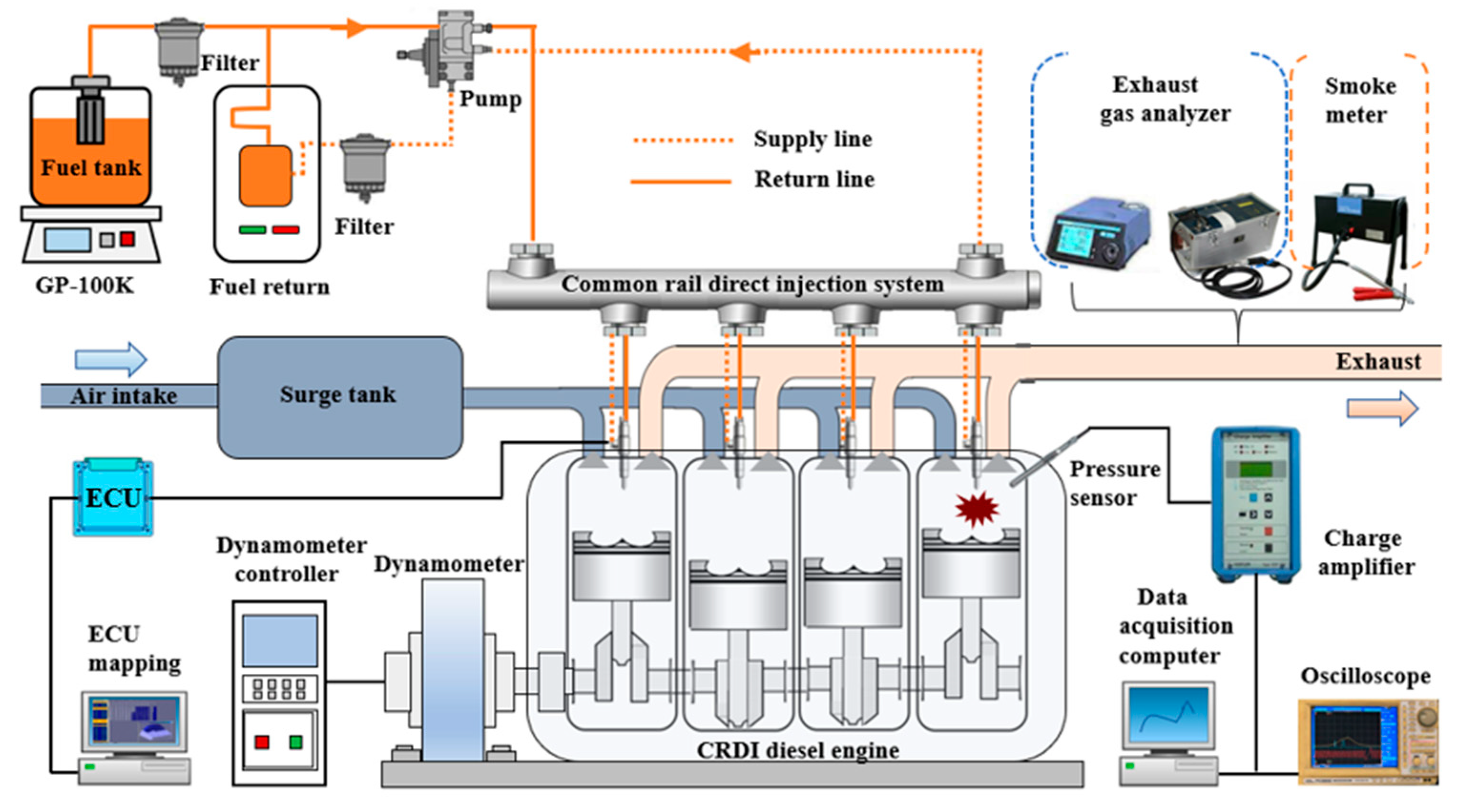
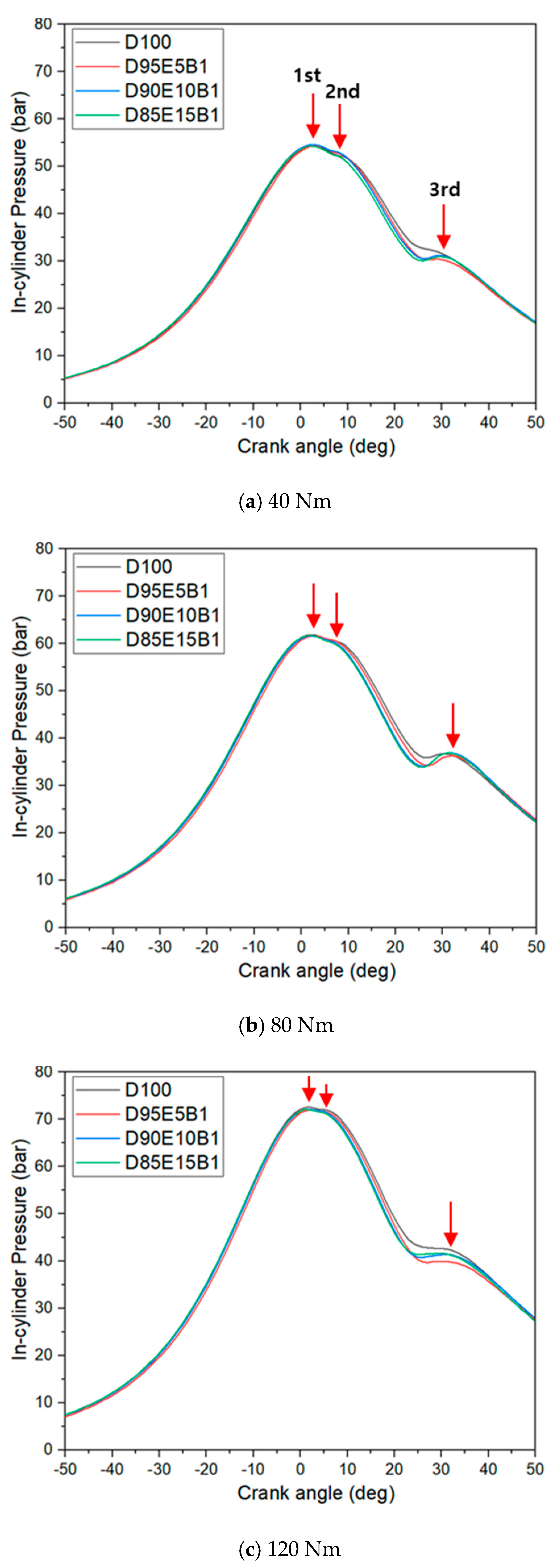
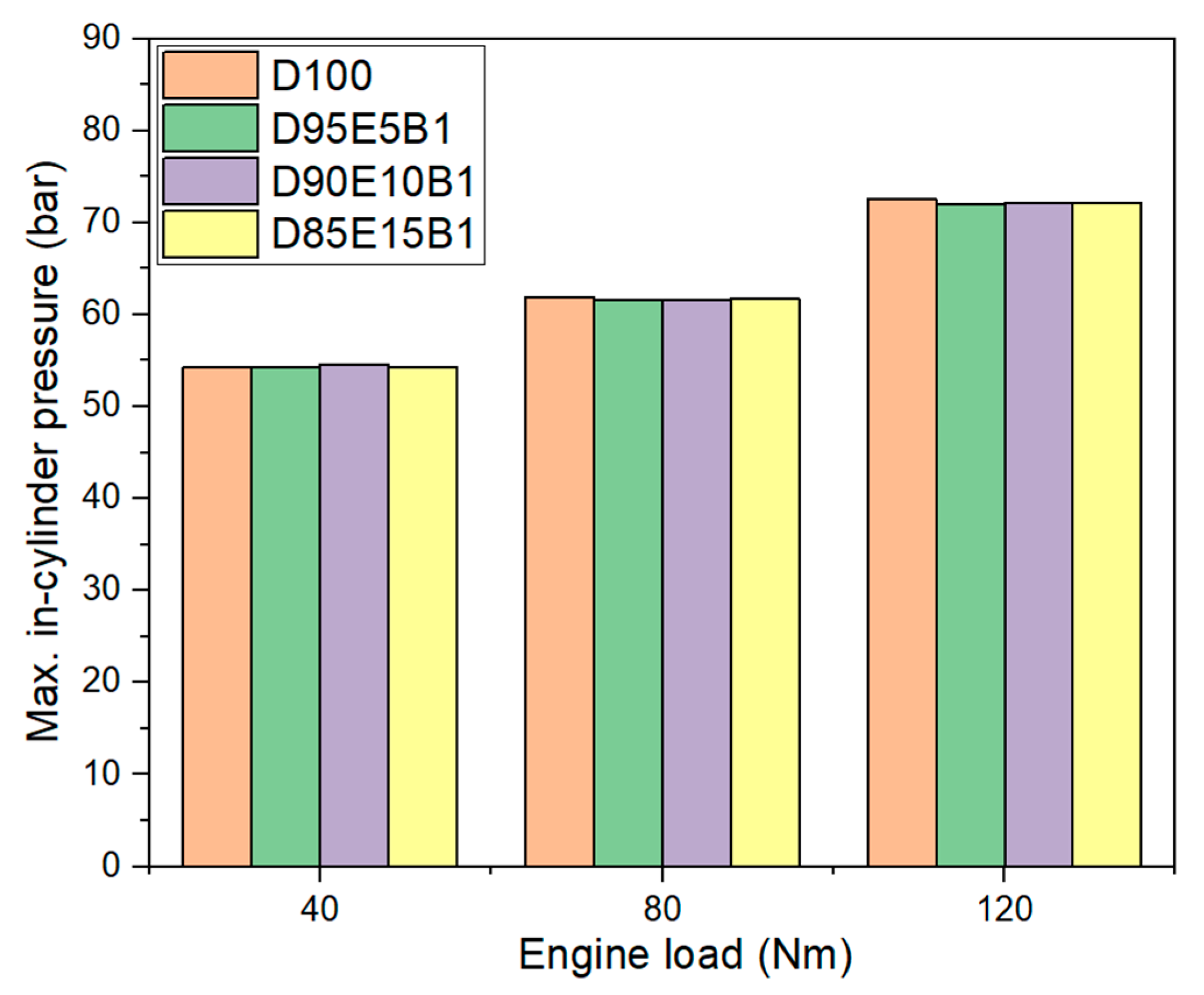
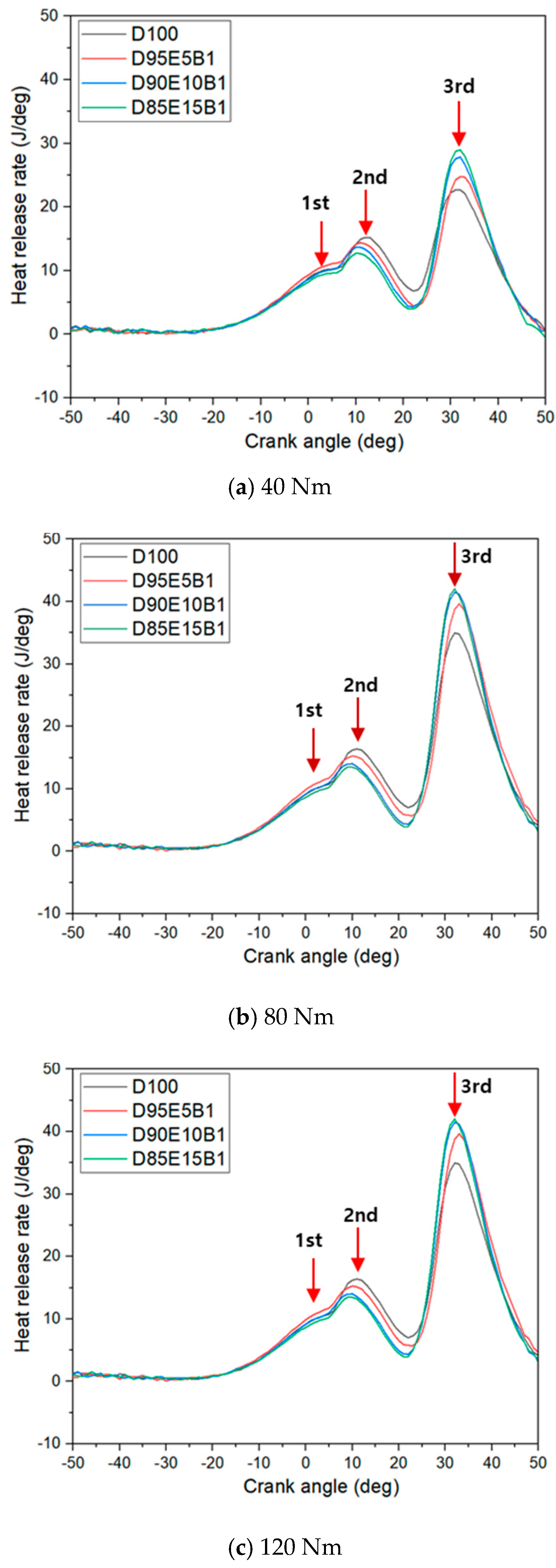
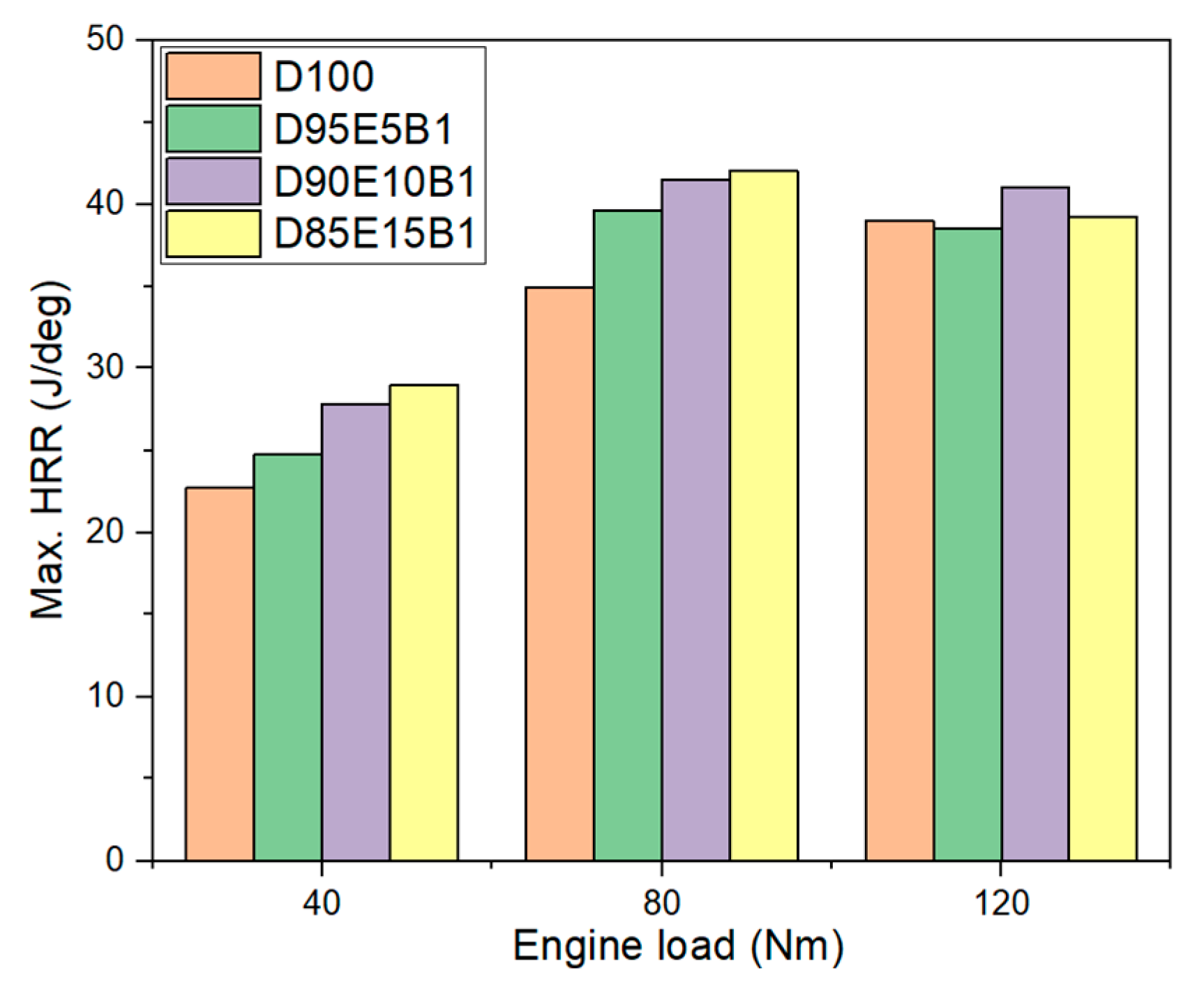
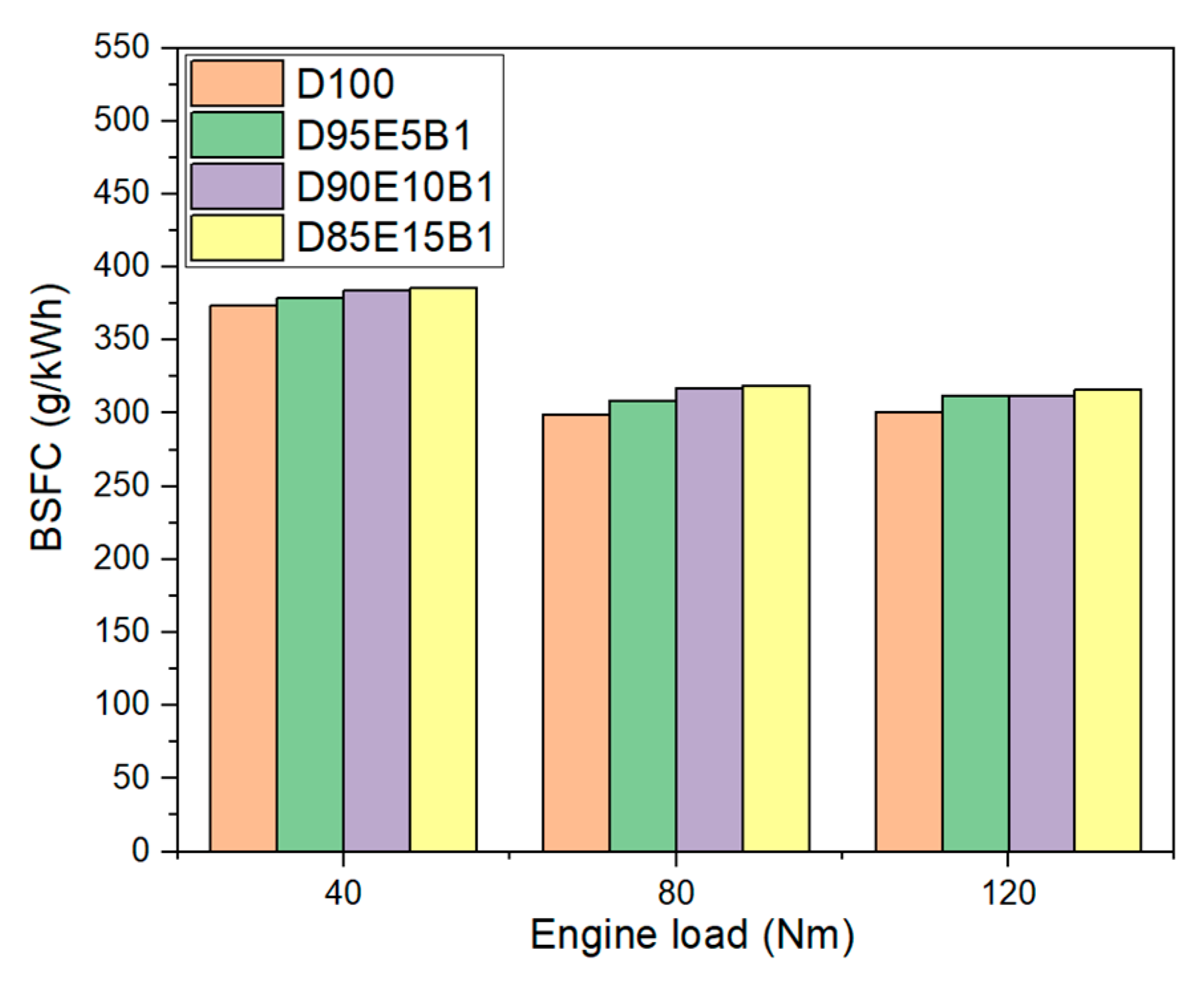
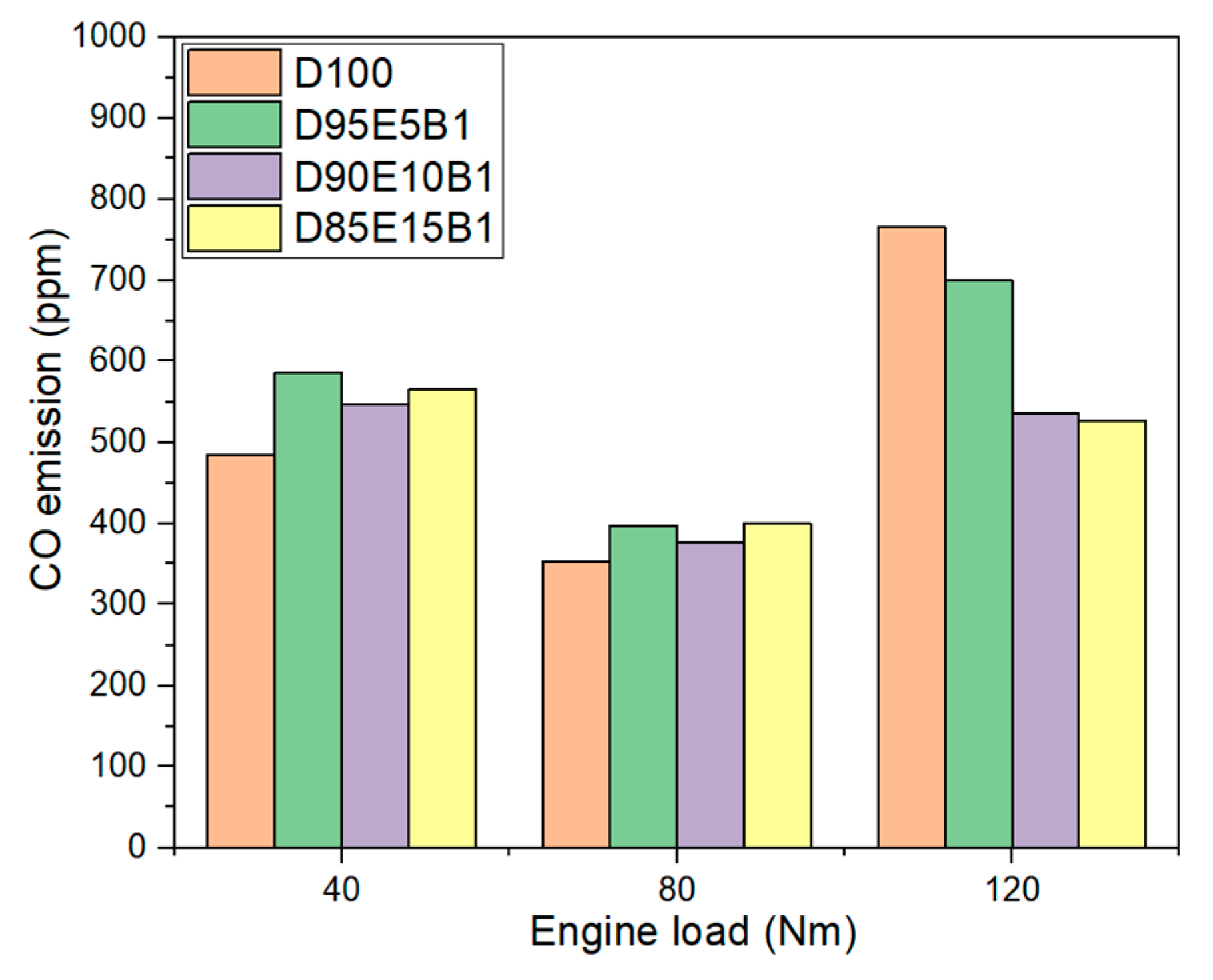
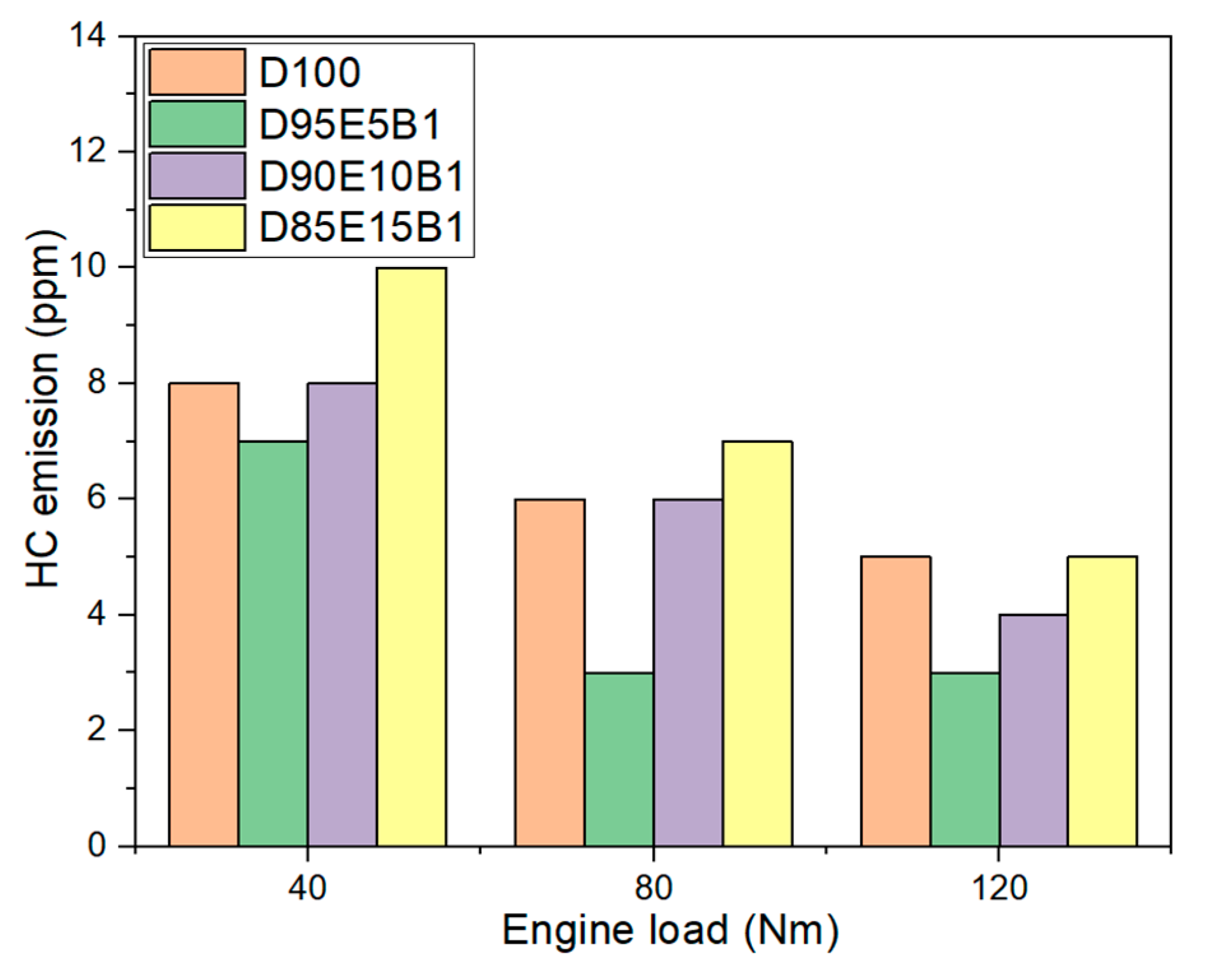
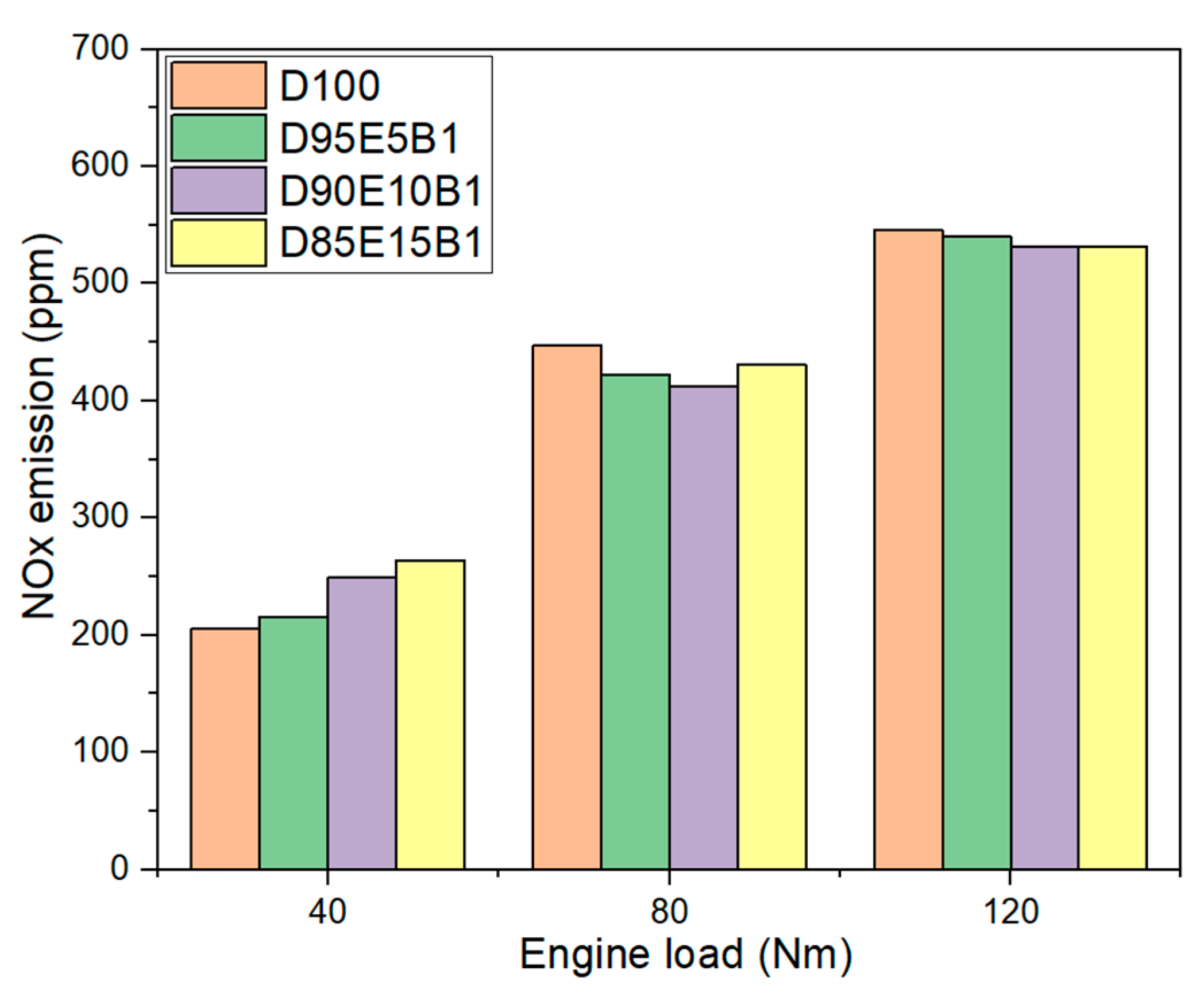
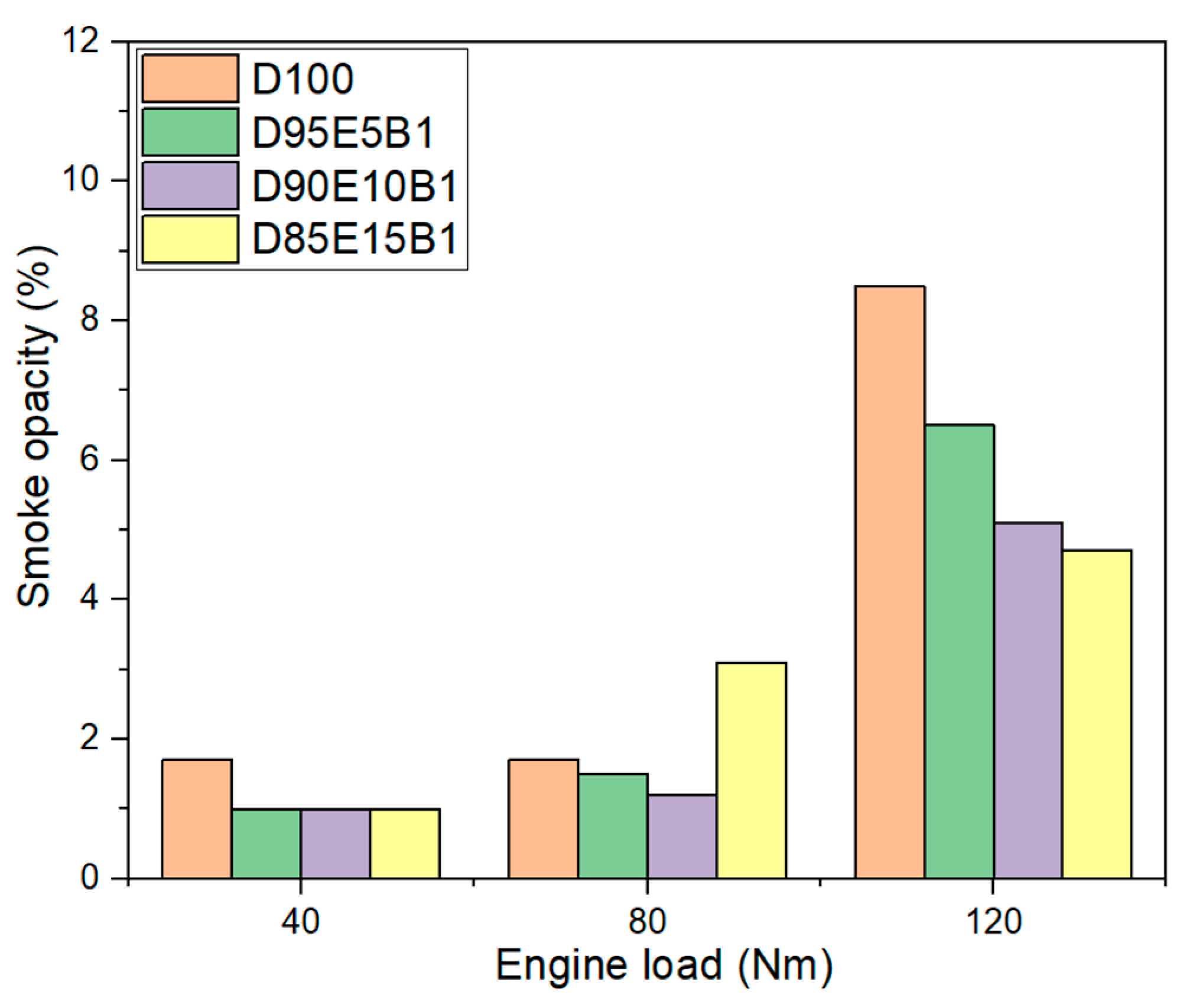
| Engine Parameter | Specifications |
|---|---|
| Engine type | In-line 4-cylinder |
| Cooling system | Water cooling |
| Air intake system | Turbocharger with WGT |
| Number of cylinders | 4 |
| Bore × stroke | 83 × 92 (mm) |
| Injector hole diameter | 0.17 (mm) |
| Number of injector nozzle holes | 5 |
| Injector spray angle | 150 (degree) |
| Compression ratio | 17.7:1 |
| Max. power | 82/4000 (kW/rpm) |
| Properties (Units) | Diesel Fuel | Bioethanol | Biodiesel | Test Method |
|---|---|---|---|---|
| Density (kg/m3 @ 15 °C) | 836.8 | 799.4 | 877 | ASTM D941 |
| Viscosity (mm2/s @ 40 °C) | 2.719 | 1.10 | 4.56 | ASTM D445 |
| Calorific value (MJ/kg) | 43.96 | 28.18 | 39.72 | ASTM D4809 |
| Cetane index | 55.8 | 8 | 57.3 | ASTM D4737 |
| Flash point (°C) | 55 | 12 | 196 | ASTM D93 |
| Oxygen content (%) | 0 | 34.7 | 11.26 | - |
| Item | Conditions |
|---|---|
| Fuel | D100, D95E5B1, D90E10B1, D85E15B1 |
| Load | 40, 80, 120 Nm |
| Speed | 1800 rpm |
| Injection pressure | 50 MPa |
| Pilot/main injection timing | 5/10° ATDC |
| Intake air temperature | 25 ± 1 °C |
| Cooling water temperature | 85 ± 1 °C |
| Device | Range | Resolution | Uncertainty |
|---|---|---|---|
| CO (ppm) | 0–4000 | 1 | ±0.62% |
| HC (ppm) | 0–10,000 | 1 | ±5% |
| NOx (ppm) | 0–6000 | 1 | ±0.25% |
| Smoke opacity (%) | 0–100 | 0.1 | ±1% |
| Engine load (Nm) | 0–833 | 0.1 | ±0.2% |
| Engine speed (rpm) | 0–10,000 | 1 | ±0.1 |
| Fuel consumption (g) | 0–101 | 1 | ±1.98 |
| In-cylinder pressure (bar) | 0–250 | 0.1 | ±0.01 |
Disclaimer/Publisher’s Note: The statements, opinions and data contained in all publications are solely those of the individual author(s) and contributor(s) and not of MDPI and/or the editor(s). MDPI and/or the editor(s) disclaim responsibility for any injury to people or property resulting from any ideas, methods, instructions or products referred to in the content. |
© 2023 by the authors. Licensee MDPI, Basel, Switzerland. This article is an open access article distributed under the terms and conditions of the Creative Commons Attribution (CC BY) license (https://creativecommons.org/licenses/by/4.0/).
Share and Cite
Ge, J.C.; Kim, J.Y.; Yoo, B.O.; Song, J.H. Effects of Engine Load and Ternary Mixture on Combustion and Emissions from a Diesel Engine Using Later Injection Timing. Sustainability 2023, 15, 1391. https://doi.org/10.3390/su15021391
Ge JC, Kim JY, Yoo BO, Song JH. Effects of Engine Load and Ternary Mixture on Combustion and Emissions from a Diesel Engine Using Later Injection Timing. Sustainability. 2023; 15(2):1391. https://doi.org/10.3390/su15021391
Chicago/Turabian StyleGe, Jun Cong, Jung Young Kim, Byeong O Yoo, and Jun Hee Song. 2023. "Effects of Engine Load and Ternary Mixture on Combustion and Emissions from a Diesel Engine Using Later Injection Timing" Sustainability 15, no. 2: 1391. https://doi.org/10.3390/su15021391
APA StyleGe, J. C., Kim, J. Y., Yoo, B. O., & Song, J. H. (2023). Effects of Engine Load and Ternary Mixture on Combustion and Emissions from a Diesel Engine Using Later Injection Timing. Sustainability, 15(2), 1391. https://doi.org/10.3390/su15021391








